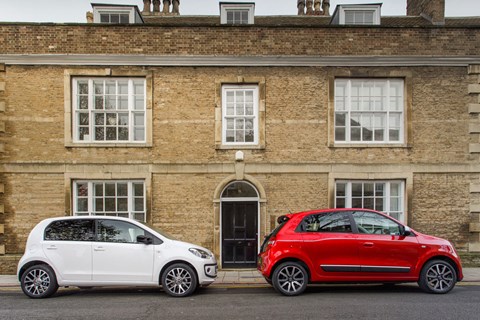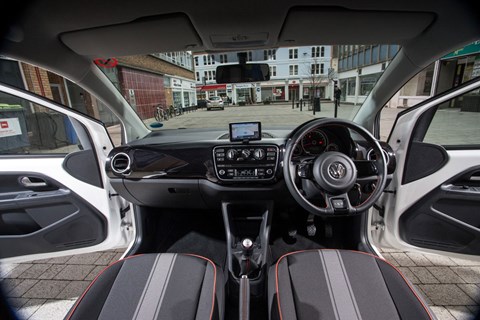► Renault’s rear-engined Twingo
► Meets VW’s conventional Up
► Which makes the better city car?
What’s interesting about this little tête-à-tête is that it pitches a small car for which a rear-engine, rear-wheel drive platform was rejected by the world’s second largest car maker on grounds of cost, against a small car only armed with precisely that platform because a third party – the world’s third largest car maker – needs it for sundry Smart purposes.
Having already seen off Fiat’s Panda, Volkswagen’s somewhat delicious Up needs no introduction. This isn’t our first thrape in a Twingo either, so let’s cut to the chase, and that which purports to give the latter’s pricey little platform the edge; advantageous packaging.
Well, mounting engine and drive astern certainly hasn’t made the Twingo any more compact overall.
It’s actually over two inches longer and two and a half inches taller than the Up. However, with a wheelbase getting on for three inches more generous than that of the VW, you’d expect the Renault at the very least to take the honours in the accommodation stakes.
From the driver’s perspective there is, ostensibly, little to choose between the two. Front seats are comfortable enough, though a lack of steering-wheel reach adjustment in either car does dictate a somewhat upright approach to the helm. But then the Twingo lobs a queen wasp in the ergonomic Pimms by leaving the driver precisely nowhere to rest his (or, more probably, her) clutch foot.
Worse, the angular, all-too-readily-demountable storage bin in front of the gear lever will keep savaging an already displaced left leg, adding further discomfort, and possible bruising. With the other side of the shin bin annoyance neatly chamfered to fit a passenger footwell which widens out along the transmission tunnel, the words ‘rat’ and ‘smell’ leap to mind in the context of Renault’s conversion to right-hand drive…

Sitting behind myself in the Twingo is tight; lolling, legs akimbo like a bloke on a banquette who’s had one too many is right out. Despite having inherited my mother’s short, fat, hairy legs, my knees are in constant contact with the front seatback. Moreover (and this may be down to the presence of a full-length canvas sunroof) my head is rammed so firmly into the roof lining I might, for all the world, be wearing a giant hat.
The rear seat itself is decidedly firm and, in the interests of increasing rear loadspace, may be rake adjusted between the Victorian and the positively vertical.
So how come, despite the shorter wheelbase, the Up gives me perceptibly more legroom astern, enough headroom to make my own choice of hat, and a more comfortable seat to boot? Hmmm. Must all come down to luggage capacity, then.
Nope. Rear seats in place, the VW boasts a loadspace 63 litres larger than the 188 litres offered by the Renault. And don’t go thinking that, 911-style, there’s bonnet space up for grabs…
Clearly armed with the collective IQ of a packet of Jaffa Cakes, it took two of us 20 minutes and an ecstasy of fumbling to fathom Twingo bonnet opening. It’s hinge-free and doesn’t so much ‘open’ as flop clumsily forwards a few inches. Indeed it’s only prevented from clattering headlong into impromptu toboggan status by a pair of nylon straps.
Aspirant luggage space already occupied by a radiator inaccessible even with the bonnet open, then, this two-man tussle reveals nought but a row of fluid top-up caps, suggesting screenwash reservoir refilling to be the work of but an eon.
So, having clearly established that the Twingo’s alternative platform singularly fails to steal packaging honours from the Up, we must presume that it will prove more competitive in, perhaps, the 4 performance or driving dynamics departments.
Both machines sport 999cc, three-cylinder, naturally-aspirated petrol powerplants. Volkswagen has bullied 5bhp and 3lb ft of torque more from its unit, but the Up is a stout 64kg heavier than the Twingo. Despite this considerable weight disparity, however, the Volkswagen is over a second quicker to 62mph and has a 14mph higher top speed.
In truth, the Up feels consistently livelier throughout the gears than this modest on-paper advantage would suggest. And this has much to do with the fact that it responds far more sharply to the throttle; the Twingo requiring a surprising degree of pedal pressure to elicit any oomph at all.
It’s the same story with the brakes; whilst the Up’s make their presence felt with the first brush of the pedal and are nicely modulated thereafter, too much unrewarded pedal travel followed by a sudden burst of over-enthusiasm makes the Twingo’s brakes particularly tricky to deploy smoothly around town.

The Renault does boast markedly superior claimed average fuel consumption and CO2 figures, but given the wholehearted throttle thrashing which must be administered to get both machines moving with any alacrity, I suspect real-world consumption figures will bear little similarity in either case.
And thrash ’em you surely will because, with less to choose between them than the variation in platform design might suggest, a surprising degree of derring-do may be extracted from either.
Though the undercarriage of both demonstrates admirable pliancy, the Twingo boasts a fractionally more comfortable ride. We are talking a very small margin, however, and a nagging suspicion lingers that this may have more to do with better cabin insulation from road noise than any true mechanical advantage.
Both offer similar, pleasingly tenacious degrees of mechanical grip allied to respectable body control, before succumbing to understeer which is tidily tempered by ABS-sponsored electronic nannies, neither of whom may be switched off.
Ultimately, however, the Twingo is a less pleasing drive, not only because its somewhat woolly gearchange fails to match the Up’s cleaner, more accurate shift, but also because its steering feels decidedly vague at top dead centre and is perceptibly less crisp and linear in its response to inputs. Lob in the fact that the Renault is all too readily socked about by crosswinds, and the whole elicits a suspicion that the absence of engine weight adhering the bows to the road is actually almost a disadvantage.
Lest we forget, the second most significant benefit cited of the Twingo’s rear-orientated platform is a turning circle on a par with an ordinary Northumberland spoke-shaver’s coracle. True, but that usefulness is somewhat outweighed by a steering rack ratio requiring at least 90 degrees more twirling than that demanded by the Up to simply negotiate a right-angled bend. And that means constantly having to move your hands on the wheel. Which is inappropriate to a city car.

When it comes to styling, I favour the Up not because I particularly prefer a giant milk carton to a giant jelly bean, but because I find the VW’s straightforward interior design considerably classier than a Twingo dashboard boasting more curves than a children’s water park. The former’s instrumentation is clearer, switchgear more pleasurable to use and the finish is of a higher quality throughout.
Connectivity honours are even, but where the Twingo provides a console switchgear-obscuring cradle in which you must mount your own smartphone for use – via a free app – as a navigation screen, the Up wins out through the simple but welcome provision of a dash-mounted Garmin.
Finally, then, price. Predictably, at £12,500, this Groove Up 1.0 75ps will set you back £1505 more than the £10,995 Twingo Dynamique SCe 70 Stop and Start. But whilst the Up we drove sported just £485 worth of optional kit, the Renault’s options hiked its price tag by £1940 (including £850 for that headroom-stealing sunroof), bringing it to within just £50 of price parity.
What we have, then, despite the most diverse possible approach to powertrain installation, is two extremely closely matched machines. For all that technical trickery, though, the Renault cannot pip the VW for packaging, performance or driving dynamics.
And that leaves the rear-engined Twingo with just two advantages; both front window switches on the driver’s door card, and the turning circle of a startled owl.